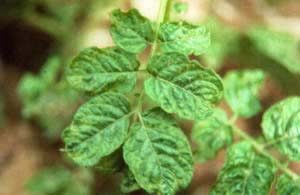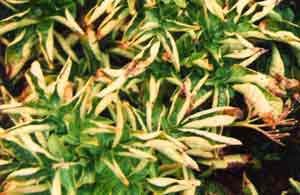Bulletin #2492, Potato Facts: Potato Diseases Caused by PVY and PLRV
Bulletin #2492, Potato Facts: Potato Diseases Caused by PVY and PLRV (PDF)
By Steven B. Johnson, Ph.D., Extension Crops Specialist
For information about UMaine Extension programs and resources, visit extension.umaine.edu.
Find more of our publications and books at extension.umaine.edu/publications/.
Potato diseases caused by viruses can cause losses in potatoes in the form of decreased yields, misshapen tubers or internal discoloration. Since viruses build up quickly in potato stocks, seed production schemes have been developed and regulations keep viruses at low levels in seed potatoes.
Viruses can be described as basically nucleic acid, DNA or RNA, surrounded by a protein coat. They are not visible without the use of an electron microscope. Viruses reproduce by having the host cell actually reproduce the virus. Viruses can be spread by fungi, insects, nematodes and leaf hoppers, and mechanically by contact between plants, plant sap or humans.
Potato Virus Y (PVY)
There are at least three strains of Potato Virus Y (PVYn, PVYc, and PVYo). The common strain (PVYo) is prevalent in Maine and the United States. PVY is one of the two most important viruses infecting potatoes in Maine and elsewhere.
Severe yield losses—up to 100 percent—are possible from this pathogen. The virus is borne on an aphid stylet and can be transmitted as quickly as in a few seconds. When aphids pick up the virus, they will not keep the virus for their entire life. However, aphids can re-acquire the virus on their stylet numerous times. The virus can also be spread mechanically by human activity. PVY can interact with other viruses, most notably PVX.
PVY causes mosaic in potatoes. The symptoms of PVY vary depending upon the strain of the virus and the variety of potato. Some potato varieties have a hypersensitive reaction to PVY. This results in rapid death of the infected area and a small dead area surrounding the infection. Some potato varieties are more sensitive to the PVY viruses and exhibit easily visible symptoms such as a mild mottling. The leaves may become distorted and brittle, often exhibiting a wrinkled and rough appearance. In addition to potatoes, tomatoes, and nightshade, plants in the Leguminosae and Chenopodiaceae groups are hosts to PVY.
To control PVY, growers should plant certified seed with low virus readings. All cutting and planting equipment should be disinfected before coming in contact with seed. Good aphid control should be practiced. Cultivation should be minimized to prevent mechanical spread of the pathogens and performed when the vines are dry. Traffic, vehicular and pedestrian, should be minimized in the field. Plants showing symptoms should be rogued as early in the season as possible, before the tops touch. Infected seed and daughter tubers should be removed and carried from the field, assuring that no contact occurs with noninfected plants. Later, roguing should be done when the vines are dry, and rogued plants should be placed in a clean sack to minimize spread within the field during the roguing process.
Potato Leaf Roll Virus (PLRV)
Potato Leaf Roll Virus (PLRV) is transmitted by aphids, primarily, the green peach aphid. When an aphid picks up the virus from an infected plant, the virus circulates through the aphid, entering the salivary glands. It is then transmitted when the aphid probes a potato plant. An aphid can acquire PLRV after a few minutes feeding but generally requires 24 – 48 hours to be able to transmit the virus. This delay helps control the spread of the virus if there are timely applications of insecticides for green peach aphid control. PLRV can only be spread by aphids.
Once infected with PLRV, an aphid will remain so for its entire life. Plants emerging from infected tubers show symptoms first on the lower leaves, and the symptoms gradually progress upward. On the plants, leaves are rolled upward and assume a brittle, leathery texture. These plants are usually yellow and may be slightly stunted.
Current-season infection of PLRV occurs when an aphid carrying PLRV probes a healthy potato plant. The resulting symptoms include a rolling upward of the top leaves, which have a reddish appearance. This symptom might be seen later in the season, in what were healthy looking plants. These symptoms may not be obvious, however. The lower leaves usually look normal.
When shaken, the leaves of a PLRV-infected plant make a sound similar to the rattling of parchment paper. Infected tubers of some varieties may show “net necrosis,” small brown strands of discolored tissue extending throughout the stem end of the tuber after a month in storage.
PLRV can be controlled by planting certified seed free from the virus. Entire infected plants should be rogued and removed. Good aphid control should be practiced to reduce the vector of the virus. Also, try to control volunteers, cull piles and weeds, including mustards, which can act as an inoculum reservoir.
Information in this publication is provided purely for educational purposes. No responsibility is assumed for any problems associated with the use of products or services mentioned. No endorsement of products or companies is intended, nor is criticism of unnamed products or companies implied.
© 1999
Call 800.287.0274 (in Maine), or 207.581.3188, for information on publications and program offerings from University of Maine Cooperative Extension, or visit extension.umaine.edu.
In complying with the letter and spirit of applicable laws and pursuing its own goals of diversity, the University of Maine System does not discriminate on the grounds of race, color, religion, sex, sexual orientation, transgender status, gender, gender identity or expression, ethnicity, national origin, citizenship status, familial status, ancestry, age, disability physical or mental, genetic information, or veterans or military status in employment, education, and all other programs and activities. The University provides reasonable accommodations to qualified individuals with disabilities upon request. The following person has been designated to handle inquiries regarding non-discrimination policies: Director of Equal Opportunity and Title IX Services, 5713 Chadbourne Hall, Room 412, University of Maine, Orono, ME 04469-5713, 207.581.1226, TTY 711 (Maine Relay System).



